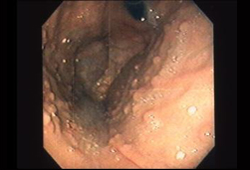Summary
Definition
History and exam
Key diagnostic factors
- family history of FAP/attenuated FAP
- teenager
- onset of colorectal cancer in middle age
- bilateral pigmentation of the retina
Other diagnostic factors
- constipation/diarrhea
- hematochezia
- extraintestinal features of familial adenomatous polyposis (FAP)
Risk factors
- germline adenomatous polyposis coli (APC) gene mutation
- family history of familial adenomatous polyposis (FAP) or attenuated FAP
Diagnostic tests
1st tests to order
- genetic testing
Treatment algorithm
FAP: without colonic adenomas
FAP: with colonic adenomas
attenuated FAP: without colonic adenomas
attenuated FAP: with colonic adenomas
Contributors
Authors
Priyanka Kanth, MD, MS, FACG, AGAF
Associate Professor of Medicine
Division of Gastroenterology
MedStar Georgetown University Hospital
Lombardi Comprehensive Cancer Center
Washington
DC
Disclosures
PK declares that she has no competing interests.
Acknowledgements
Dr Priyanka Kanth would like to gratefully acknowledge Dr Charles A. Ternent, Dr Alan G. Thorson, Dr Lisa A. Boardman, and Dr Douglas L. Riegert-Johnson, the previous contributors to this topic.
Disclosures
CAT, AGT, LAB, and DLRJ declare that they have no competing interests.
Peer reviewers
Galen Leung, MD
Assistant Professor of Clinical Medicine
Perelman School of Medicine
University of Pennsylvania
Philadelphia
PA
Disclosures
GL declares that he has no competing interests.
Jatin Roper, MD
Assistant Professor of Medicine
Duke University School of Medicine
Duke University
Durham
NC
Disclosures
JR declares that he is a consultant for Microbial Machines.
Yann Parc, MD, PhD
Professor of General Surgery
Department of Digestive Surgery
Hopital Saint-Antoine
Universite Pierre et Marie Curie Paris VI
Paris
France
Disclosures
YP declares that he has no competing interests.
Gabriela Moslein, MD
Editorial Board
Allgemein- und Viszeralchirurgie
St Josefs-Hospital Bochum-Linden
Dusseldorf
Germany
Disclosures
GM declares that she has no competing interests.
Peer reviewer acknowledgements
BMJ Best Practice topics are updated on a rolling basis in line with developments in evidence and guidance. The peer reviewers listed here have reviewed the content at least once during the history of the topic.
Disclosures
Peer reviewer affiliations and disclosures pertain to the time of the review.
References
Key articles
National Comprehensive Cancer Network. NCCN clinical practice guidelines in oncology: genetic/familial high-risk assessment: colorectal, endometrial, and gastric [internet publication].Full text
Yang J, Gurudu SR, Koptiuch C, et al. American Society for Gastrointestinal Endoscopy guideline on the role of endoscopy in familial adenomatous polyposis syndromes. Gastrointest Endosc. 2020 May;91(5):963-82.e2.Full text Abstract
Hyer W, Cohen S, Attard T, et al. Management of familial adenomatous polyposis in children and adolescents: Position paper from the ESPGHAN polyposis working group. J Pediatr Gastroenterol Nutr. 2019 Mar;68(3):428-41.Full text Abstract
Poylin VY, Shaffer VO, Felder SI, et al. The American Society of Colon and Rectal Surgeons Clinical Practice Guidelines for the management of inherited adenomatous polyposis syndromes. Dis Colon Rectum. 2024 Feb 1;67(2):213-27.Full text Abstract
Zaffaroni G, Mannucci A, Koskenvuo L, et al. Updated European guidelines for clinical management of familial adenomatous polyposis (FAP), MUTYH-associated polyposis (MAP), gastric adenocarcinoma, proximal polyposis of the stomach (GAPPS) and other rare adenomatous polyposis syndromes: a joint EHTG-ESCP revision. Br J Surg. 2024 May 3;111(5):znae070.Full text Abstract
Reference articles
A full list of sources referenced in this topic is available to users with access to all of BMJ Best Practice.

Differentials
- MUTYH polyposis
- Juvenile polyposis
- Peutz-Jeghers syndrome
More DifferentialsGuidelines
- NCCN clinical practice guidelines in oncology: genetic/familial high-risk assessment: colorectal, endometrial, and gastric
- Clinical practice update on nonampullary duodenal lesions: expert review
More GuidelinesPatient information
Colon and rectal cancer: what is it?
Colon and rectal cancer: what are the treatment options?
More Patient informationLog in or subscribe to access all of BMJ Best Practice
Use of this content is subject to our disclaimer